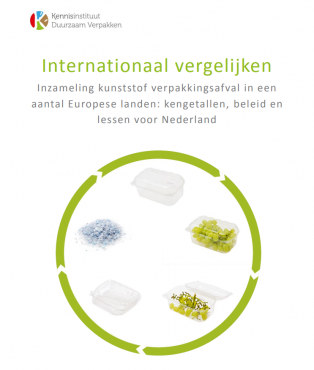International Comparison
The International Comparison work package, part of the plastic chain project, is intended to determine where five other European nations stand with regards to closing their plastic packaging materials chain, both in terms of raw materials and in an economic sense. The main objective of this work package is to derive starting points for interventions that can be used in the Netherlands.
 Three types of collection and recycling systems that are common in the EU were analysed and compared:
Three types of collection and recycling systems that are common in the EU were analysed and compared:
comprehensive collection of all plastic packaging waste, as seen in Germany and the Netherlands;
selective collection of some forms of plastic packaging waste, as seen in Belgium and France;
sorting of plastic packaging waste by manual pickers, as seen in Greece and the Czech Republic.
The international comparison was drawn up based on desk research and interviews.
For each country, the report describes how that country handles its producer responsibility and what the country’s performance pertaining to the stream of domestic plastic packaging materials is.
Key results
The results show that each country handles producer responsibility in its own way. The table below shows the extent to which the various countries manage to close their plastic chain, both in terms of raw materials and in an economic sense. The results achieved in the Netherlands have been included for comparison. A clarification of abbreviations used is given below.
Clarification of abbreviations; MPW=Municipal plastic packaging waste; BPW= Plastic packaging waste from businesses; NA=Not Available. * The percentage realised in the Czech Republic pertains to collection, because this country has set a collection target rather than a recycling target.
** The cost recovery rate after sorting is 0%. This is due to the average negative revenue of sorted plastic packaging waste. The figure of the cost recovery rate after recycling is based on calculations with the Financial-Economical Model. The calculations pertain to plastic packaging waste from households and from the deposit-refund system only. The cost recovery rate of beverage cartons and metal packaging, in case of plastic collection with PMD, are not included in this calculation.
*** This percentage does not include the deposit-refund flow and pertains to the total amount of domestic plastic packaging waste onto the market and not to the amount licensed.
(*1) The country report has been presented for evaluation to the relevant national organisations to eliminate any factual inaccuracies.
(*2) The country report has been evaluated by the relevant national organisations to eliminate factual inaccuracies.
Based on the aforementioned performances per country, the interventions used in each country were evaluated. The most valuable interventions that could possibly be applied in the Netherlands have been selected from the country reports and are listed below. For each intervention, it is listed whether it affects the physical or economic closing of the plastic packaging chain. For each intervention, the information between parentheses indicates from which country the intervention in question was “taken” (BE for Belgium; FR for France; CZ for the Czech Republic; GR for Greece; DE for Germany).
The impact of the interventions listed above largely depends on the chosen system and the conditions under which the interventions are implemented. Copying any specific intervention directly does not guarantee a similar effectiveness in the Netherlands.
Conclusions
Based on the results presented and the underlying mechanisms the following conclusions can be made:
Germany, together with the Netherlands are front runners in regard to the achieved recyclingrates. Both Germany and the Netherlands have different forms of comprehensive collection systems in place. In an economic sense the Netherlands achieves the lowest cost recovery rate of the examined countries. This is due to the relatively high collection and sorting costs and the relatively low revenues from the sale of the sorted domestic plastic packaging waste.
Longstanding uniform and consistent collection systems throughout the country combined with unified communication will lead to an optimum in response rate and offer a more stable composition of the collected material. This can be strengthened by financial stimuli towards citizens to sort their packaging waste better and active control on contaminants during collection.
Mechanical biological waste treatment is hardly applied internationally. The Netherlands could play a front runner role in this field.
The country reports of Germany and Belgium show that centralised chain oversight during collection, sorting and commodification of domestic plastic packaging waste result in lower costs and higher revenues.
Stimulating a free market for the collection and sorting processes[1] through regular tenders. For several of the examined countries this has contributed to lower collection and sorting costs than in the Netherlands.
Selective sorting at the source can result in a high cost recovery rate but limits the feasible recycling rate.
Differentiated rates which promote improved recyclability of materials is being applied internationally.
This study shows that the Czech Republic collects plastic packaging and plastic non-packaging materials together in one bin. The costs for the plastic non-packaging are not covered by the producer responsibility. The complexity of the stream will increases with this combination.
Download
Klik hier voor de interactieve landkaart met de lessen uit het buitenland.